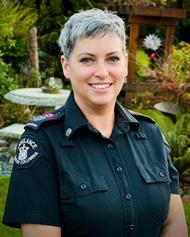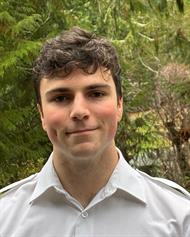As we celebrate BCEHS’ 50 years of service, many of the stories have involved longtime employees, innovative pioneers, and how our organization has changed and grown over the last half century. However, it would be remiss not to also consider how BCEHS is looking ahead to the next 50 years by showcasing the Youth Observer program.
The Youth Observer program was created by Deb Roberts, Youth Pathways Lead for BCEHS. It’s part of the Youth Pathways suite of programs offered to youth at age-appropriate levels.

There’s a Grade 9 ‘Day in the Life of a Paramedic’ event, which is delivered in schools by local paramedics who run kids through standardized curriculum and provide basic first aid training. For Grade 10s, there is a two-day camp done in partnership with schools involving more hands-on CPR training and AED certifications, as well as ‘Stop the Bleed’ tourniquet training and Naloxone training.
Through Deb’s efforts, BCEHS has partnered with several schools around BC to offer the Justice Institute of British Columbia (JIBC) emergency medical responder (EMR) course to Grade 11 and 12s. The post-secondary course is taught by high school faculty and prepares students for EMR certification, paving the way into entry-level roles in emergency medical services and health care.
There were four schools involved in the program in 2024, with another eight schools offering the program to students in 2025, and dozens more elsewhere in the province are in discussions with BCEHS to facilitate access to training for their students in the future. The Youth Pathways team also recently partnered with Columbia Medical to offer a First Responder program to youth in Ahousaht starting in January 2025.
Since BCEHS doesn’t hire potential paramedics until they turn 19, Deb wanted to come up with something to bridge the gap for students who had graduated with their EMR license but weren’t yet old enough to be considered for a career with BCEHS.
That’s how the Youth Observer program, which sees 17- and 18-year-olds doing ambulance ride-alongs with paramedics, came about. It is intended as a means of maintaining connections with students and keeping them engaged, as ride-alongs had previously been restricted to would-be hires who were at least 19-years-old.
“We want to keep them going down this path, and they also need patient contacts and continued medical competency courses to be able to maintain their license,” Deb said. “We created the Youth Observer program so they can ride third on an ambulance.”
“We put them through a few paces: they must do an interview, their parents get interviewed, they sign confidentiality forms, they get a criminal record check. They must get fit tested at a local station and then we schedule them out on car. They can do two or three shifts to see if this is what they like before they jump in and do more schooling and decide if this is for them or not.”
Logan Jones is a Youth Observer program trailblazer: he took a first responder program offered by his high school in Grade 11. When it came time to apply for university, his initial plan was to major in business – but participating in BCEHS’ Youth Observer program changed that.

At first, Logan didn’t quite understand the full scope of what paramedics do, but he got up to speed quickly. He attended several intense calls while riding third as part of the program and found he enjoyed the thrill of learning about the level of medicine and care that BCEHS paramedics perform in high pressure environments.
Logan says the more calls he attended, the more interested he became in medicine as a whole. When he first realized he wanted a career in medicine, his initial thought was to become a trauma surgeon – but upon considering the length of schooling that would involve, he started thinking about becoming a paramedic more seriously.
Logan soon applied for primary care paramedic (PCP) training and did another two ride-alongs to gain experience. He recently finished his PCP education and expects to receive his PCP license in February 2025, but in the interim, he is working as an EMR in Lillooet while attending nursing school online.
“It’s been a really, really great experience to kind of move from watching people do things to actually being the one to do things,” Logan said of the transition from education to on-car work.
He found that the time he spent doing ride-alongs with the Youth Observer program came in handy when he was hired on, and he was able to share some of his knowledge and experience with other new staff going through the New Employee Orientation (NEO) program.
Ultimately, Logan’s goal is to continue furthering his paramedic skills and education, with the plan to eventually obtain his critical care paramedic (CCP) license. To do this, he will first need to obtain his advanced care paramedic (ACP) license, and he anticipates that the nursing program will also give him a good head start on some of the critical care knowledge he plans to tackle in the future.
Logan got a taste of the critical care world this summer when he did a critical care ride-along on one of BCEHS’ helicopters, attending calls on Vancouver Island and in the Sea to Sky region.
“I love aviation and I love medicine – that really tied it together,” he said. “It was incredible to see the level of medicine [critical care paramedics are] practicing, as well as the complicated logistics factors of transporting a patient by air.”
Like Logan, Carter Duperron took an EMR program in high school – though his JIBC course was run in partnership with BCEHS.

Carter’s interest in paramedicine began in Grade 10. He remembers being handed a form for the Career-Life Education program that included ‘Emergency Medical Responder’ (EMR) in the list of courses he could take over the next two years. When the teachers explained what an EMR was and what the program would involve, Carter jumped at the opportunity. He took the EMR program with two of his best friends, and the three of them successfully passed the course.
As it happened, Carter was part of the impetus for BCEHS’ development of the Youth Observer program itself.
“Deb called me her guinea pig for setting up the junior program to ride third as a junior,” he said. “I was only 18 at the time, and they were only doing 19-year-olds for the riding third.”
After graduation, Carter decided to keep the momentum rolling and enroll in the PCP program right away. But before heading down to Victoria to attend the in-class portion of the course, he took the opportunity to ride third with local paramedics as part of the newly developed Youth Observer program.
“It was very different going from [the EMR course] to then go riding third, which I thought was crazy good experience,” he said. “It was definitely a different world.”
Carter, also a volunteer firefighter, had gone out on first responder calls before, but said that riding third solidified his plan to make a career of paramedicine. After spending four months in Victoria doing the PCP course, he returned to his hometown to spend more time on-car for his practicum.
One of Carter’s first calls during his practicum was particularly nerve-wracking – but he says the learning experience was invaluable.
“We had gotten, I think, two calls earlier that day, and they were both yellow (lower acuity), so it was kind of a calm day at first,” Carter said. “We’re about an hour and a half off the end of our shift, and the tone comes on for a purple (critical).”
“I had about two minutes and 30 seconds to prepare mentally, and then we hopped out of the ambulance and we walked right into a cardiac arrest. It was definitely good to experience early on, kind of get the feel of what to expect, because that's probably one of the most stressful calls – it was nice to get it out of the way.”
Carter turned 19 in July and immediately applied to work for BCEHS, accepting a position in his hometown of Port Alberni in December.
Deb says getting young aspiring paramedics on-car with the Youth Observer program has many benefits – both for BCEHS and for the youth themselves.
“It builds confidence. It gives them mentorship. It gives them connections within the service,” she said.
And when it comes to Logan and Carter specifically, Deb is excited for the future.
“I believe they’re going to have long-lasting, exceptional careers, because they planned it out, they put in the time and the effort and lined up their ducks to make it happen – at 19 years of age,” Deb said. “It’s pretty cool to witness and the full circle moments that make it all worthwhile.”
